![]()
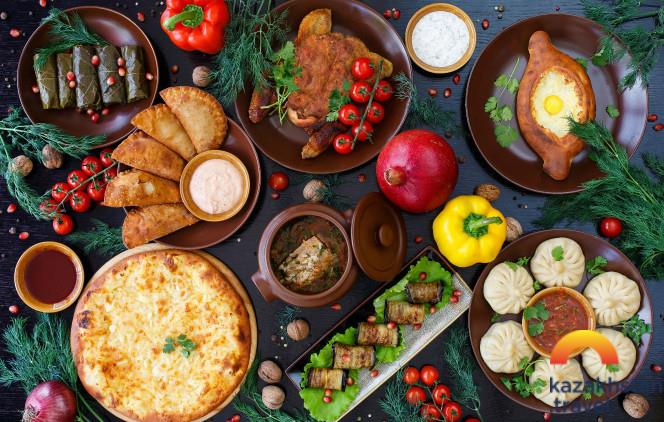
Since Kazakhstan is a multinational state (Kazakhs, Russians, Greeks, Tatars, Uyghurs, Koreans, Germans and many other nationalities live together peacefully and harmoniously), various cuisines of the world are presented in the country extensively.
Contrary to popular belief, gastronomic predilections are not limited to traditional Kazakh food or Oriental food. That’s why in any city of this huge country there are many cafes, restaurants and other dining places where you can try dishes popular in various and remote parts of the world.
Russian, European, Oriental, Asian, Pan-Asian and even American cuisine – whatever well-defined or gourmet taste preferences you have, you will definitely find something suitable.
Clearly, a “cherry on top” of this gastronomic variety is traditional Kazakh food that conveys national flavour of the steppe to the full.
Russian Cuisine
Russian cuisine, due to several centuries of tight cultural interaction between the two states, has taken deep roots in local life.
Because of its simplicity and nutritiousness, Russian food is a big part of daily meals of every Kazakhstani. Moreover, Russian dishes are widely served in many restaurants where these are prepared in accordance with age-old traditions and old recipes with the addition of original ingredients.
What are these dishes and what is possible to try in Kazakhstan?
The way of life and geographical location played an important role in shaping daily meals in ancient Russia: mushrooms, fish, various grains, vegetables and meat were stewed, baked, simmered in jugs placed in huge stove right in the middle of izba (Russian wooden house).
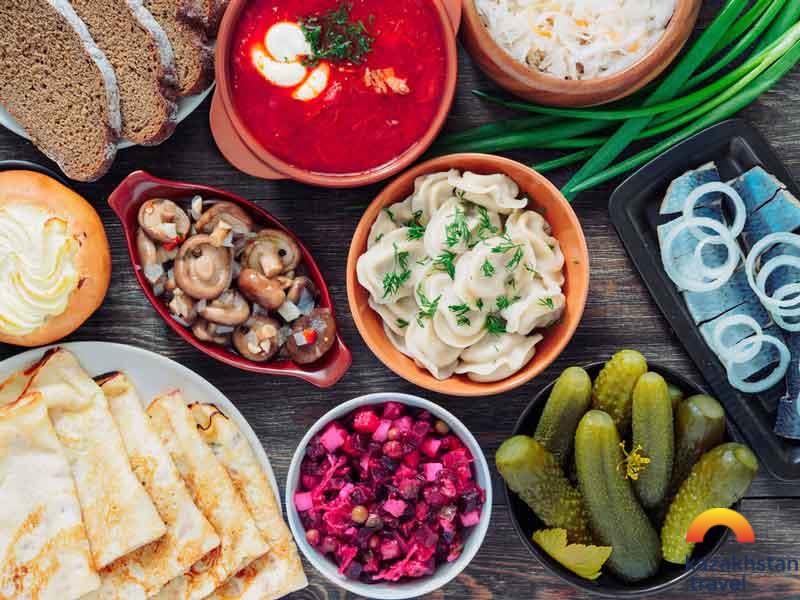
Like in any national cuisine, a meal is served over several courses. The first course is a traditional Russian soup – borsch (beetroot-cabbage soup), ukha (fish soup), shchi (vegetable soup), rassolnik (meat/fish soup with pickled cucumbers) – rich and fragrant, based on triple broth, served with a sour cream and a piece of fresh bread.
The second course are, usually, pelmeni (meat dumplings), cow-heel, flesh of pike, stewed sturgeon, famous Russian meat pies and mushrooms pies.
Of course, Kazakhs can’t do without desserts and delicacies. Hardly anybody can resist soft lacy bliny (pancakes with honey, jam, red or black caviar), sweet kalach (sweet soft white bread), pryaniki (cookies in crispy syrup), pastila (colourful fruit and berries paste) and baked berries and fruits.
Traditional Russian drinks are equally tasty: refreshing kwas (mildly alcoholic drink made from fermented rye bread), spicy and hot sbeeten (mulled honey drink), fragrant mors (fruit or berry drink) with light sour taste and spirit-lifting medovukha (or honey wine).
After such a meal you can’t be bothered doing anything, but just sitting and having a talk, enjoying your feeling of fullness and satisfaction from tasty dishes.
European Cuisine
European Cuisine in Kazakhstan has become quite popular and has been demanded by local people since long. Almost every third dining place concentrates on cuisines of European countries such as Germany, Czech Republic, Ireland, England, Italy and France.
Of course, the menu usually consists of dishes that comply with the firmly established taste preferences of Kazakhs.
Which European dishes are available in the centre of Eurasia?
Dishes such as French-style meat, Italian pizza and pasta and Greek salad are easily available. But the restaurant industry in Kazakhstan is rapidly developing and, in order to stir up interest of demanding folks, chefs are always coming up with new dishes in the menus, complying with European standards.

In cozy Italian restaurants you will be offered bruschetta (grilled bread rubbed with garlic and usually topped with tomatoes, olive oil, salt and pepper) with various fillings, delicious types of cheese and antipasto (cold and hot appetizers), great variety of pasta (from Carbonara to Fettuccine), risotto (rice dish with the addition of broth), ravioli (dumplings usually served with a pasta sauce), pizza on thin dough, beef ossobuco (cross-cut veal shanks braised with vegetables, white wine and broth), and many other traditional dishes.
French cuisine in Kazakhstan include dishes like quiche (incredibly tasty open-faced tart with bacon eggs and cheese), onion soup, ratatouille (a vegetable stew), tartiflette (gratin with potatoes, cheese, cream and pork), salad Nicoise (various ingredients, but always with black olives and tuna), Savoy fondue (made with cheese and white wine into which cubes of bread are dipped), delicious desserts: blancmange (made with milk or cream and sugar thickened with gelatin, corn starch, flavoured with almonds), eclaire (oblong pastry filled with cream and topped with chocolate icing), crepes Suzette (pancakes with Suzette sauce: caramelized sugar and butter, orange juice, zest, liqueur).
Popular dishes from British cuisine include: Beef Wellington (beef cooked in a pastry crust), English Shepherd’s pie (a meat pie with a crust or topping of mashed potato), pork rump steak, beef steak, Lancashire mutton, and also many delicious desserts – crumble (stewed fruit topped with a crumbly mixture of butter, flour, and sugar), cheesecake, Yorkshire pudding (soufflé batter baked in very hot oven), trifle (cold dessert with varied ingredients) and lemon curd.
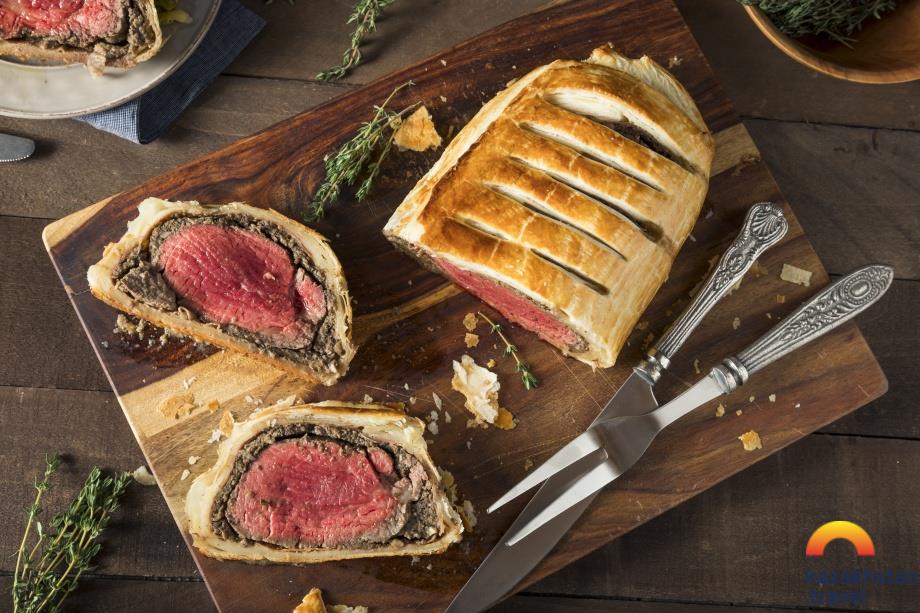
German cuisine is also quite popular among Kazakhstani people – a roll from duck meat, schnitzel (meat thinned by pounding with meat tenderizer and fried in oil), various types of meat sausages (bratwurst, bockwurst, weisswurst, currywurst), Eisbein (ham hock with vegetables), salmon or carp in various sauces, Alsatian apple pie, strudel (layered pastry with, usually, sweet filling), and many other dishes.
On top all of these, there are quite exotic dishes of Dutch, Austrian, Irish and Czech cuisines in the menus of many restaurants; not a great choice but still there is something to choose from.
Historically, European cuisine has become popular since the Russian Empires, when European scientists and merchants travelled to the Kazakh steppes as part of expeditions. Globalization has also played its role; daily meals of average Kazakhstani citizens contain dishes originating in Europe.
Oriental Cuisine: Pan-Asian and Turkic dishes
Long before that, dining places serving Oriental cuisine won popularity in Kazakhstan due to similarity of taste preferences; especially taking into account the incredible variety of meat dishes and delicious desserts presented in Oriental cuisine.
It can be divided into two large groups – Pan-Asian and Turkic. The first group includes very popular Chinese, Korean and Japanese dining places.
Rolls, sushi, sweet meat and hot spices
Kazakhs associate these dishes with Pan-Asian cuisine. Korean and Chinese food is in great demand among those who like spicy, unusual, and at the same time light dishes.
Rice, meat, noodles, vegetables, seafood are basic ingredients of many traditional dishes. Spicy taste and rich flavour of spices, that Pan-Asian cuisine is so much loved for, are created by combinations of sesame seed oil, olive or rape seed oil with various fragrant spices, garlic, ginger powder and soya sauce.
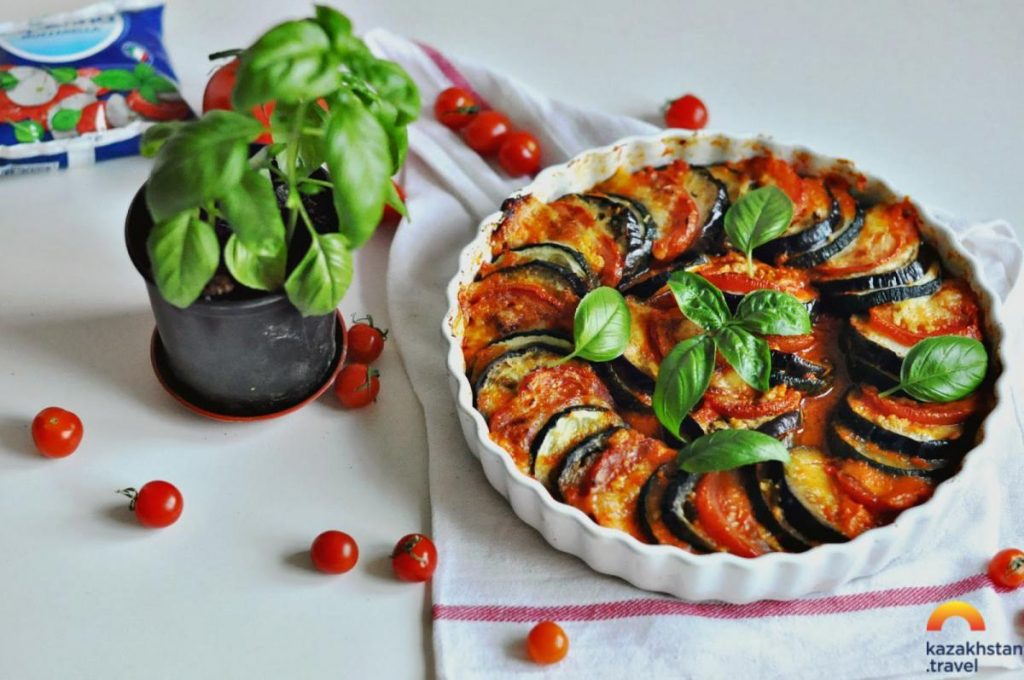 In Korean restaurants in Kazakhstan you can try true taste of traditional dishes and appetizers, because such places are often owned by ethnic Koreans who have saved ancient recipes and supply all necessary ingredients directly from South Korea.
In Korean restaurants in Kazakhstan you can try true taste of traditional dishes and appetizers, because such places are often owned by ethnic Koreans who have saved ancient recipes and supply all necessary ingredients directly from South Korea.
Ethnic Koreans appeared on the territory of Kazakhstan due to cruel Far Eastern policy of USSR when around 100,000 Koreans were deported to Kazakhstan and, literally, left there to the mercy of fate.
Local people helped poor and shocked deportees to survive in the cold steppe; that is how Koreans started settling down in Kazakhstan.
Korean cuisine, which is quite popular and widespread in post-Soviet countries, however differs from the food people eat in modern South Korea. in Kazakhstan, restaurants replace many specific ingredients with food products available in local markets and common to local population (various types of sea grass and some types of fish and seafood).
Recipes are also adjusted in such a way not to shock Kazakhs who are not used to hot spicy food.
Despite this, people love Korean food and enjoy cooking it. Especially, they like hot meat dishes like pulgogi (grilled marinated beef), jokbal (pig’s feet served with red salted shrimp sauce), galbi (marinated beef), galbitang (soup made from beef rib), gamjatang (soup made with pork spine), samgyetang (chicken soup), seolleongtang (ox bone soup) and Korean grill, samgyeopsal (pork strips).
Traditional Japanese food is also quite popular in Kazakhstan – sushi (fresh or fermented fish/seafood with rice), rolls (rice and other ingredients are covered with nori stripes – black sea grass), nigiri-sushi (bite-sized vinegared rice topped with sliced fresh seafood), gunkan (rice and fish covered with nori stripes), sashimi (raw thinly sliced fish or shellfish), yakitori (barbecued chicken skewers), tempura (deep-fried vegetables or seafood), different types of noodles (ramen – Chinese-style wheat noodles; udon – wheat noodles; and soba – buckwheat noodles).
It is believed that the way these dishes are served and their well-balanced composition create atmosphere of harmony and peacefulness so one can enjoy the meal.
Only fresh ingredients of the highest quality are used for cooking: seafood, rice, sea grass, vegetables, sometimes beef and chicken. Kazakhstani chefs have excellently adopted Japanese best cooking practices – many sushi bars and restaurants serve various specific dishes; some restaurants even invited chefs directly from Japan.
This is all an indicator and a result of historical closeness between Kazakhstan and Oriental countries that have got common trade and political ties since ancient times. Many countries of modern Asia were connected with Kazakhstan owing to the Great Silk Road so Pan-Asian dishes had already arrived in Kazakh steppes at those times.
Hospitable East
Traditional cuisine of many Oriental nationalities (including Turkic) is closely related to traditional Kazakh cuisine, and this fact is reflected in many dishes of modern Kazakhstan.
The nain peculiarity that made Kazakh food famous and recognised all over the world is that it can satiate you for long hours.
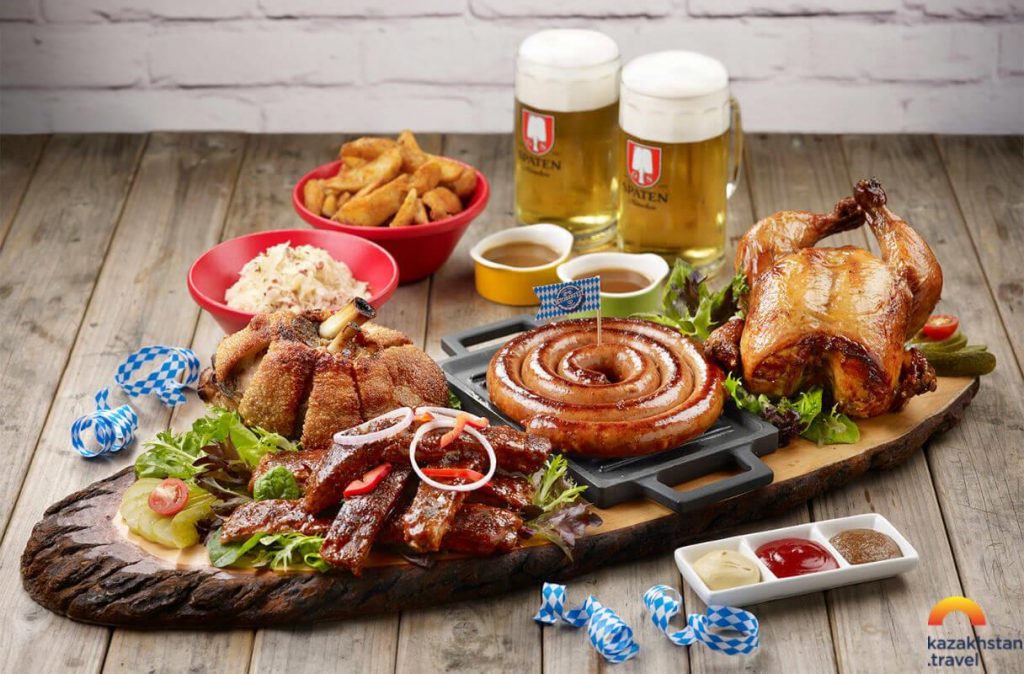 The food mainly consists of meat, milk, grains. Also baking has always been an important feature of Oriental cuisine and a decoration of any celebration – local people love it and can prepare it in due order.
The food mainly consists of meat, milk, grains. Also baking has always been an important feature of Oriental cuisine and a decoration of any celebration – local people love it and can prepare it in due order.
Gastronomic freedom
Kazakhstani people are used to the term “Oriental Cuisine” and unite several different directions under this term; among these there are Asian (Uzbek, Tatar, Uyghur) and Caucasus (Georgian and Armenian) cuisines.
Sometimes, you can get even dishes from Balkan States, for example, Turkish food. Similar approach in handling and preparation of meat and dairy products brings these cuisines together, as well as plentifulness of meat-pasta dishes.
Uzbek cuisine – one of the most popular and favourite food on the territory of Kazakhstan. Bright variety of rich and delicious dishes is the best explanation of this fact.
In local restaurants you can try all sorts of fried/baked pastry with meat – belyash, cheburek, samsa; dolma (chopped mutton with spices rolled in vine leaves); chuchvara (Uzbek dumplings); mampar (soup with doughboys); bedana kabob (barbecued quails), and many more.
The favourite dish in Kazakhstan is traditional Uzbek plov (fried meat with rice, carrots and Uzbek spices).
Georgian cuisine is also in high demand, especially among those who love baked food and delicious cheese.
One can try khachapuri (suluguni cheese-filled bread, sometimes with eggs and other ingredients), pkhali (paste made of vegetables and pureed walnut sauce), lobio (mashed red beans with spices), satsivi (meat in walnut sauce), chakhokhbili (tomato based soup with poultry meat), rich and fragrant beef soup kharcho (beef, tomatoes, herbs and walnuts), delicious khinkali (dumplings filled with meat, potatoes or cottage cheese), meat with satsebeli hot sauce (made of tomato paste, cilantro, garlic, vinegar, pepper, khmeli suneli set of spices) and tsitsila tapaka (fried chicken).
Uyghur cuisine brings joy with its huge portions and pure rich taste of various dishes: sai (a stir-fried topping made from mutton and vegetables with spices), sambusa (small lamb pies baked in a special brick oven), ganfan (rice with sai topping), kawap (grilled meat), chushurya (Uyghur dumplings), dapandji (type of chicken stew), lagman or leghmen (noodles with sai topping).
Kazakhs also like tasty tea accompanied by sweet desserts. That’s why Turkish cuisine has also ideally fitted into local gastronomic mentality.
Almost everywhere you can try delicious Turkish desserts like sherbet, pakhlava or rakhat-lukum; all of these have distinctive and memorable tastes due to a lot of nuts, honey, dried apricots and fruit juice in their compositions.
Kazakhstan has got a lot of cultural ties since ancient times and that fact remarkably influenced the gastronomic preferences of its people.
Almost each cuisine, from European to Pan-Asian seafood, is available in Kazakhstan.












